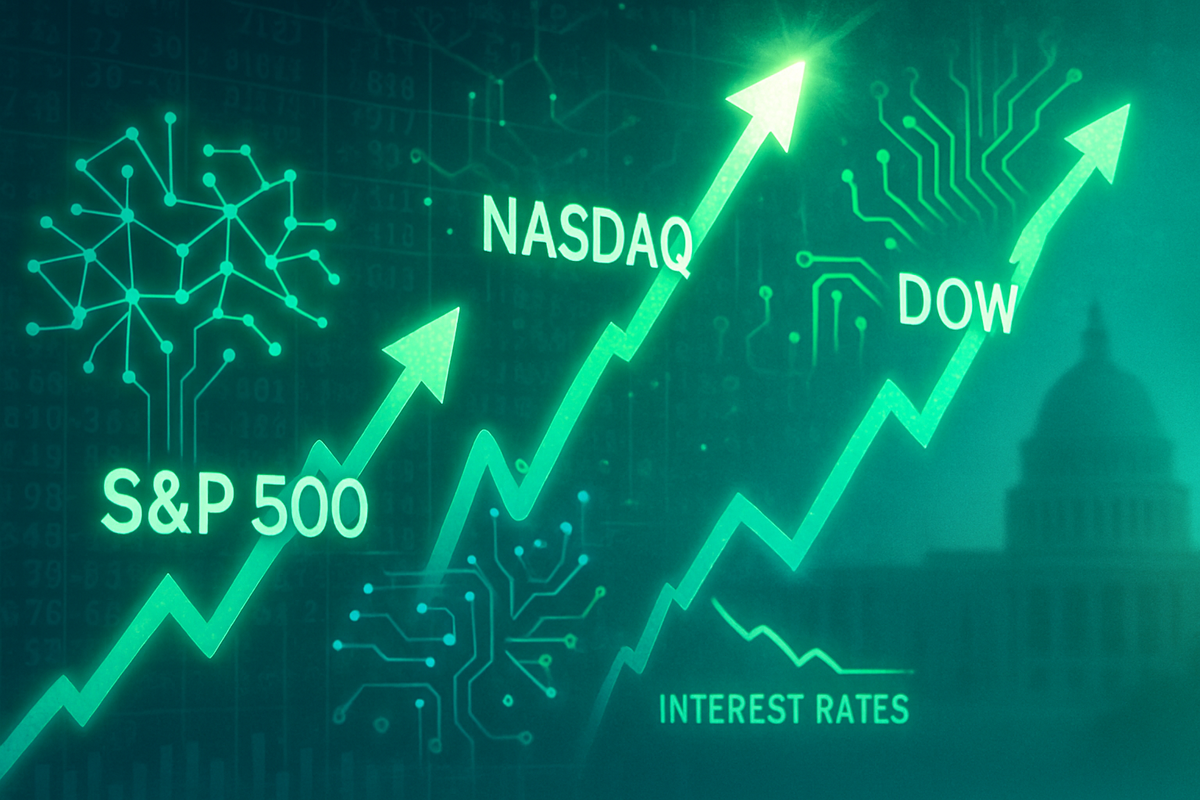
New York, October 2, 2025 – The U.S. stock market is currently experiencing an extraordinary period, with the S&P 500, Nasdaq Composite, and Dow Jones Industrial Average all shattering previous records. This remarkable surge, unfolding in early October 2025, is primarily fueled by an insatiable appetite for artificial intelligence (AI) innovation and growing expectations of further interest rate cuts by the Federal Reserve. This bullish sentiment has largely overshadowed concerns arising from an ongoing U.S. government shutdown, painting a picture of a resilient market driven by technological advancement and anticipated monetary easing.
The immediate implications of these record highs are a significant boost to investor confidence and a clear signal that, for now, the market is prioritizing technological growth and favorable monetary policy over political gridlock. While the government shutdown introduces a degree of uncertainty, the market's initial reaction suggests a belief that its economic impact will be contained, allowing the powerful tailwinds of AI and lower interest rates to continue propelling equity valuations upward.
Detailed Market Ascent Amidst Economic Crosscurrents
On Thursday, October 2, 2025, major U.S. stock indices extended their impressive rally, reaching fresh record highs for the second consecutive day. The benchmark S&P 500 hit a record intraday high of 6,726.55, climbing 0.23% after the opening bell, following a record close above 6,700 on Wednesday, October 1st. The tech-heavy Nasdaq Composite advanced by 0.33% to 22,831.05, while the venerable Dow Jones Industrial Average (DJIA) rose 0.23% to 46,547.37, also setting new records. These milestones mark a continuation of a robust third quarter, which saw the Nasdaq soar 11.2%, the S&P 500 add 7.8%, and the Dow advance 5.2%.
The timeline leading to these highs is marked by several significant developments. The U.S. government entered its second day of a shutdown on October 2nd, a situation that historically has had limited long-term market impact. Crucially, earlier in the week, an unexpected ADP report indicated a loss of 32,000 private-sector jobs in September, the largest decline since March 2023. This surprisingly weak employment data played a pivotal role in solidifying market expectations for further interest rate cuts from the Federal Reserve.
Key drivers behind the rally include overwhelming enthusiasm for AI, which continues to drive investment and innovation across the technology sector. News of OpenAI's surging valuation to $500 billion and strategic partnerships with South Korean chipmakers like Samsung (KRX: 005930) and SK Hynix (KRX: 000660) for its "Stargate" AI infrastructure project further fueled chipmaker shares globally. Beyond AI, strong corporate earnings continue to defy slowdown concerns, with many S&P 500 companies reporting better-than-expected results. Initial market reactions have been broadly positive, with technology (XLK) leading S&P 500 sector gains, and bond yields fluctuating as investors digested the economic data and rate cut expectations.
Corporate Fortunes: Winners and Losers in the AI-Driven Market
The current market environment, characterized by record highs propelled by AI optimism and anticipated rate cuts, is creating clear winners and posing significant challenges for others. Companies at the forefront of AI development and infrastructure are reaping substantial rewards, while those slow to adapt or in traditional sectors face headwinds.
Leading the charge are AI chip manufacturers and hardware providers. Companies like Nvidia (NASDAQ: NVDA), Broadcom (NASDAQ: AVGO), Micron Technology (NASDAQ: MU), and Advanced Micro Devices (NASDAQ: AMD) are experiencing "insatiable demand" for their advanced GPUs and high-bandwidth memory, critical for AI training and data centers. Taiwan Semiconductor Manufacturing Co. (NYSE: TSM), as a primary contract manufacturer, also benefits immensely from increased chip orders. Furthermore, infrastructure partners like Vertiv Holdings Co. (NYSE: VRT), which provides cooling and power solutions for data centers, are seeing heightened investor attention in this "AI infrastructure arms race."
Hyperscale cloud providers and the "Magnificent Seven" tech giants are also major beneficiaries. Microsoft (NASDAQ: MSFT), Alphabet (NASDAQ: GOOGL), Amazon (NASDAQ: AMZN), and Meta Platforms (NASDAQ: META) are investing billions in data center expansion to support their AI initiatives, driving significant capital expenditure. Oracle (NYSE: ORCL) has successfully pivoted, with its cloud infrastructure (OCI) experiencing high demand for AI workloads. AI software and application developers like Palantir Technologies (NYSE: PLTR) and Applovin (NASDAQ: APP) are also thriving by effectively translating AI capabilities into revenue. The anticipation of Federal Reserve rate cuts further boosts these growth-oriented companies by reducing borrowing costs and increasing the present value of their future earnings.
Conversely, the rapid advancement of AI is also creating disruptions and potential losers. Many companies, even large tech players like IBM (NYSE: IBM) and Salesforce (NYSE: CRM), are undergoing significant layoffs and restructuring, as AI-driven automation replaces certain roles in software engineering, HR, and customer support. Smaller, unprofitable AI startups with stretched valuations are vulnerable to market corrections if their growth disappoints. Traditional industries and cyclical sectors, often more sensitive to government spending and consumer activity, may lag the tech-heavy indices, as evidenced by the Dow's slower growth compared to the Nasdaq and S&P 500. Companies reliant on government contracts could also face direct impacts from the shutdown, while credit bureaus like TransUnion (NYSE: TRU) and Equifax (NYSE: EFX) face potential disruption from new mortgage lending practices that bypass their services.
A Broader Lens: Significance, Trends, and Historical Echoes
The current market highs signify a profound shift in economic drivers, with Artificial Intelligence emerging as the undeniable "preeminent growth driver." The global AI market, projected to quintuple over the next five years, is not just a trend but a fundamental reshaping of industries. This concentrated growth, particularly within the "Magnificent Seven" tech stocks now comprising 34% of the S&P 500, highlights a powerful, yet potentially vulnerable, market dynamic. The relentless demand for AI capabilities is fueling massive capital expenditure in semiconductors and cloud infrastructure, creating a positive feedback loop for key enablers in the ecosystem.
This AI-driven boom has significant ripple effects. While it propels tech giants and their partners, it also creates a bifurcated market. Companies unable to rapidly integrate AI or whose business models are challenged by AI-powered competitors face increased pressure. For instance, the decline in DocuSign (NASDAQ: DOCU) shares after OpenAI launched a competing product illustrates AI's disruptive power. The robust performance of the tech sector also contrasts with lagging traditional industries, which are more susceptible to economic shifts and the potential impacts of the government shutdown. The increased use of AI by "bad actors" for cyberattacks is, ironically, also boosting the cybersecurity market.
From a regulatory and policy standpoint, the rapid global adoption of AI is accelerating the pace of AI regulation worldwide. The ongoing U.S. government shutdown adds another layer of complexity. Crucially, it delays the release of vital economic data, including monthly jobs and inflation figures. This "flying partially blind" scenario could complicate the Federal Reserve's monetary policy decisions regarding interest rates, potentially increasing market volatility. Historically, U.S. government shutdowns have had a limited, short-lived impact on the stock market, with the S&P 500 often remaining flat or even rising. However, prolonged or repeated shutdowns could eventually erode investor confidence. While current valuations are high, historical data suggests that valuations are often poor predictors of short-term performance, though concerns about an "AI market bubble" persist, drawing comparisons to the Dot-Com era.
What Comes Next: Navigating Opportunities and Challenges
As the U.S. market basks in record highs, the path forward presents a mix of exciting opportunities and inherent challenges. In the short term, the market's resilience, despite the government shutdown, suggests continued investor confidence in corporate earnings and the Federal Reserve's dovish stance. However, a prolonged shutdown could eventually dampen sentiment, especially as the delay in crucial economic data creates an information vacuum for investors and policymakers.
Looking to the long term, analysts remain largely optimistic. Goldman Sachs projects the S&P 500 to reach 6,800, driven by strong corporate performance, while J.P. Morgan Research anticipates further gains, potentially reaching 7,500 by mid-2026 in a bull case. This optimism is underpinned by the transformative potential of AI and expectations of continued earnings growth. However, concerns about elevated valuations, with the S&P 500's price-to-earnings ratio nearing dot-com bubble levels, suggest that future returns might be more modest. The "circular" nature of the AI ecosystem also poses a risk if growth expectations are not met. Historically, October has been a month of increased market volatility, reminding investors of potential headwinds.
For companies, strategic pivots are essential. Continued heavy investment in AI integration and innovation is non-negotiable for maintaining competitiveness. Diversifying revenue streams and embracing digital transformation are crucial for traditional industries. Investors, too, must adapt by thoughtfully rebalancing portfolios, considering hedging strategies, and maintaining a long-term perspective. Opportunistic investing during market dips could prove beneficial. Emerging markets present a mixed picture, with some semiconductor-heavy nations benefiting from the AI boom, while others face economic headwinds.
Potential scenarios include a continued bull market driven by AI and rate cuts, a market correction/pullback due to overvaluation or a prolonged shutdown, a soft landing with sector rotation as the rally broadens beyond tech, or even stagflationary concerns if inflation persists amid a weakening labor market. The ongoing government shutdown's impact on economic data, the Federal Reserve's next moves on interest rates, and the sustained performance of the AI sector will be pivotal in shaping these outcomes.
Wrap-Up: A Resilient Market in a Transformative Era
The current record-setting rally in the S&P 500, Nasdaq, and Dow marks a significant chapter in financial market history, characterized by remarkable resilience in the face of political uncertainty. The key takeaways are clear: the AI revolution is a powerful, enduring force reshaping global economies and driving unprecedented market valuations. Coupled with the Federal Reserve's pivot towards interest rate cuts, this creates a potent cocktail for equity markets. The market's ability to largely shrug off a government shutdown, while noteworthy, also highlights a potential complacency towards political risks.
Moving forward, the market's trajectory will be heavily influenced by the interplay of these dominant factors. The sustainability of the AI boom, the Federal Reserve's precise execution of monetary policy, and the eventual resolution and economic fallout (or lack thereof) from the government shutdown will be crucial determinants. While optimism abounds, the elevated valuations warrant a degree of caution.
For investors, vigilance is paramount. In the coming months, closely watch the resolution of the government shutdown and its impact on economic data releases. Pay keen attention to the Federal Reserve's upcoming FOMC meeting in October for further guidance on interest rate policy and any signals regarding future cuts. Monitor earnings reports from key AI players and the broader corporate landscape to assess the breadth and depth of economic health. Finally, keep an eye on labor market trends and inflation data, as these will heavily influence the Fed's decisions and the overall economic outlook. This era of technological transformation and shifting monetary policy demands a nuanced and informed approach to investing.
This content is intended for informational purposes only and is not financial advice.






